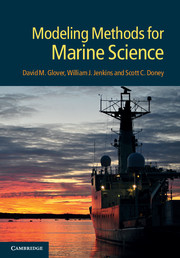Book contents
- Frontmatter
- Contents
- Preface
- 1 Resources, MATLAB primer, and introduction to linear algebra
- 2 Measurement theory, probability distributions, error propagation and analysis
- 3 Least squares and regression techniques, goodness of fit and tests, and nonlinear least squares techniques
- 4 Principal component and factor analysis
- 5 Sequence analysis I: uniform series, cross- and autocorrelation, and Fourier transforms
- 6 Sequence analysis II: optimal filtering and spectral analysis
- 7 Gridding, objective mapping, and kriging
- 8 Integration of ODEs and 0D (box) models
- 9 A model building tutorial
- 10 Model analysis and optimization
- 11 Advection–diffusion equations and turbulence
- 12 Finite difference techniques
- 13 Open ocean 1D advection–diffusion models
- 14 One-dimensional models in sedimentary systems
- 15 Upper ocean 1D seasonal models
- 16 Two-dimensional gyre models
- 17 Three-dimensional general circulation models (GCMs)
- 18 Inverse methods and assimilation techniques
- 19 Scientific visualization
- Appendix A Hints and tricks
- References
- Index
18 - Inverse methods and assimilation techniques
Published online by Cambridge University Press: 05 June 2012
- Frontmatter
- Contents
- Preface
- 1 Resources, MATLAB primer, and introduction to linear algebra
- 2 Measurement theory, probability distributions, error propagation and analysis
- 3 Least squares and regression techniques, goodness of fit and tests, and nonlinear least squares techniques
- 4 Principal component and factor analysis
- 5 Sequence analysis I: uniform series, cross- and autocorrelation, and Fourier transforms
- 6 Sequence analysis II: optimal filtering and spectral analysis
- 7 Gridding, objective mapping, and kriging
- 8 Integration of ODEs and 0D (box) models
- 9 A model building tutorial
- 10 Model analysis and optimization
- 11 Advection–diffusion equations and turbulence
- 12 Finite difference techniques
- 13 Open ocean 1D advection–diffusion models
- 14 One-dimensional models in sedimentary systems
- 15 Upper ocean 1D seasonal models
- 16 Two-dimensional gyre models
- 17 Three-dimensional general circulation models (GCMs)
- 18 Inverse methods and assimilation techniques
- 19 Scientific visualization
- Appendix A Hints and tricks
- References
- Index
Summary
Reports of my assimilation have been greatly exaggerated.
Captain Jean-Luc PicardIn Chapter 10 we introduced optimization techniques for finding unknown model parameters by minimizing a model–data cost function. Here we extend those concepts to generalized inverse and data assimilation methods. Inverse modeling actually covers a number of related numerical approaches and is applicable to a wide range of oceanographic problems, essentially any system where we want to interrogate data to help better constrain a model. Often we can measure the state of the ocean, say the temperature, density, inorganic carbon, or nutrient distributions, much better than we can determine the governing processes (in this case, circulation, mixing, air–sea fluxes, and biological uptake and release). Inverse techniques allow us to take advantage of the wealth of ocean data. With the rapid growth of satellite and ocean observing system data, inverse modeling will likely continue to grow in popularity.
The chapter starts with an introduction to the concepts behind linear inverse modeling (Section 18.1). Many ocean-related inverse problems involving tracer transport can be written as a set of linear equations, and we therefore focus in some detail on methods for solving under-determined linear systems (Section 18.2). To illustrate some of the basic ideas, we present an example case of computing the horizontal velocity field from geostrophic balance and tracer budgets using ocean hydrographic sections (Section 18.3). We follow with brief introductions to more advanced approaches such as variational data assimilation and Kalman filtering (Section 18.4).
Information
- Type
- Chapter
- Information
- Modeling Methods for Marine Science , pp. 489 - 515Publisher: Cambridge University PressPrint publication year: 2011
